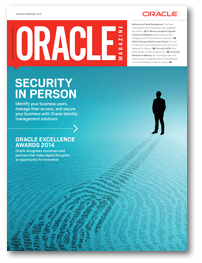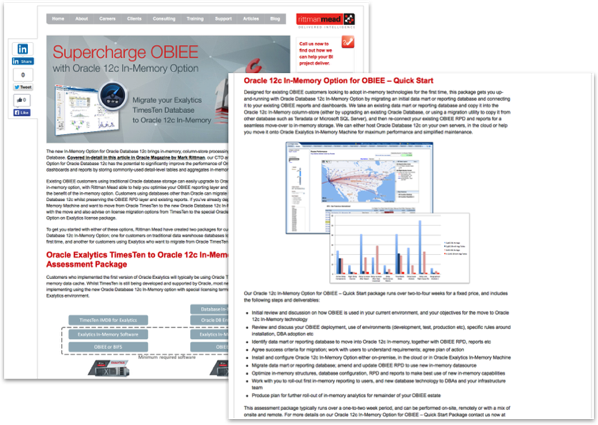OBIEE and the Oracle Database 12c In-Memory Option - Article and New Services from Rittman Mead
 My latest Business Intelligence column for Oracle Magazine is on the In-Memory Option for Oracle Database 12c, and using it to speed-up dashboards and reports in OBIEE11g. In the article I go through the basics of the in-memory option explaining how it adds in-memory columnar processing to the standard Oracle Database Enterprise Edition, and then I take the Airline Flight Delays dashboard in the OBIEE11g SampleApp v406 and enable it for in-memory processing; for queries that go against the base detail-level tables in the Oracle Database queries run roughly twice-as-fast, whilst queries going against aggregate tables return data instantaneously, all without any need to alter the underlying database schema or migrate to a new database engine.
My latest Business Intelligence column for Oracle Magazine is on the In-Memory Option for Oracle Database 12c, and using it to speed-up dashboards and reports in OBIEE11g. In the article I go through the basics of the in-memory option explaining how it adds in-memory columnar processing to the standard Oracle Database Enterprise Edition, and then I take the Airline Flight Delays dashboard in the OBIEE11g SampleApp v406 and enable it for in-memory processing; for queries that go against the base detail-level tables in the Oracle Database queries run roughly twice-as-fast, whilst queries going against aggregate tables return data instantaneously, all without any need to alter the underlying database schema or migrate to a new database engine.
To my mind there are two main groups of customers who could benefit from moving to Oracle Database 12c and the In-Memory Option; customers who are currently using earlier version of Oracle Database with regular disk-stored row-based storage (or indeed customers using other databases, for example Teradata or Microsoft SQL Server), and customers who’ve implemented Oracle Exalytics with TimesTen as the in-memory database cache, and who would now like to take advantage of the additional features and lower cost-of-ownership with in-memory processing directly in the Oracle Database.
If you already have licenses for Oracle Database Enterprise Edition you’ll only need to add the additional In-Memory Option license to enable these new features, whereas if you’re using TimesTen on Exalytics there are special terms for customers who wish to trade-in those licenses for Oracle Database Enterprise Edition and In-Memory Options licenses - and once you’ve moved over to Oracle Database 12c and the In-Memory Option, you’ll benefit from:
- Access to full Oracle SQL including advanced analytics functions, aggregation and transformation capabilities
- Moving to Oracle’s strategic database technology for in-memory analytics and Exalytics in-memory aggregate caching
- Compatibility with existing Oracle Database functionality, making it easy to move reporting databases into Exalytics and enable for in-memory analytics
- Columnar processing, an alternative to traditional row-based storage that’s better suited to BI-style filtering against attribute values
- Full compatibility with all reporting and ETL tools that support access to Oracle Database data sources
- Additional optimisations around aggregation, table joining and other BI-style queries
- Faster dashboards, more interactive reporting and less maintenance compared to maintaining TimesTen
To get you started with either of these options, Rittman Mead have created two packages for customers looking to adopt Oracle Database 12c In-Memory Option; one for customers on traditional data warehouse databases looking to use In-memory for the first time, and another for customers using Exalytics who want to migrate from Oracle TimesTen. Full details of these two packages are now up on our website at our Supercharge OBIEE with the Oracle 12c In-Memory Option web page, or you can contact us at [email protected] to talk through your particular requirements in more detail.
